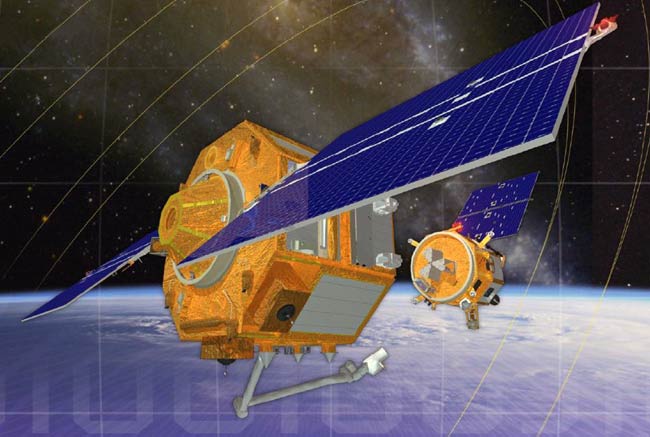Orbital Express: Prototype Satellites Primed for In-Flight Service

Twoprototype spacecraft, one wieldingits own robotic arm, are poised to launch spaceward late Thursday on athree-month mission to test methods for robotically refueling satellites in Earth orbit.
A United LaunchAlliance Atlas 5 rocket is slated to launch the two spacecraft,collectively known as Orbital Express, and a clutch of microsatellites at 9:37p.m. EST (0237 GMT) from Florida's Cape Canaveral Air Force Station [image].The planned flight is part of the U.S. Air Force's Space Technology Program 1(STP-1) mission.
"I thinkwe're feeling pretty good about it," USAF Lt. Col. Fred Kennedy, projectmanager for Orbital Express, said in a telephone interview. "We're veryconfident that we're going to have a nice successful mission."
Built forthe Defense Advanced Research Projects Agency (DARPA), the Orbital Expressvehicles are aimed at demonstrating autonomous spacecraft refueling andservicing techniques [video,image].
Formilitary uses, such capabilities would allow reconnaissance satellites to keepstation over specific areas of interest and tank up on vital propellant later,though the technology could also aid general-use spacecraft in need of periodicequipment repairs, replacements or an orbital boost, mission managers said.
"I thinkit's extremely valuable for the entire space arena," Kennedy said of OrbitalExpress' goal, adding that the mission could help ease the stringentrequirements of long-life satellites."Maybe you can accept a level of imperfection that will allow you to go uplater and perform upgrades and perform repairs, and put more propellant onboardto get the job done. That will be a sea change in the way we do business."
Servicevia automaton
Breaking space news, the latest updates on rocket launches, skywatching events and more!
The $300million Orbital Express vehicles come in two forms: the smaller target NextSatand the larger service spacecraft ASTRO [image].
Short for Autonomous Space Transport Robotic Operations, the ASTROservicing satellite is a 2,100-pound (952-kilogram) vehicle laden with 300pounds (136 kilograms) of hydrazine propellant and measuring about six feet(1.8 meters) tall and wide. Its robotic arm is designed to either latch ontoNextSat and pull it close for a manual docking, or transfer replacementhardware, such as a battery, from ASTRO to the target vehicle.
The500-pound (226-kilogram) NextSat, meanwhile, is a three-foot (about one-meter)wide prototype for a next-generation satellite designed with in-flightrefueling and servicing in mind [image].
"Our goalis to demonstrate on-orbit refueling, component exchange and satelliterepair--all without a human operator," James Lee, head of AutomatedRendezvous and Docking Projects at NASA's Marshall Space Flight Center, which developedpart of the autonomous navigation system to be used on Orbital Express.
That NASAnavigation system, first flown during the space agency's DARTautonomous rendezvous mission in 2005, and will be combined with Boeing-builtsensors, passive detection systems and computer software to allow ASTRO to keepclose tabs on NextSat, mission managers said.
"ASTROis most often flying itself," Kennedy said, adding that the vehicle is expectedto function with minimal intervention by flight controllers at Kirtland AirForce Base in New Mexico. "We are basically sitting there waiting to watch for telemetryand other data tot tell us, '"Did it work? Is there a problem? Do we need tointervene?'"
During its planned 91-daymission, the Orbital Express vehicles are expected to go through a two-weekcheckout period, and then test initial refueling and equipment replacementtechniques -- while still mated to one another -- using ASTRO's robotic arm. Aseries of more complicated rendezvous, robotic arm and servicing scenarios arethen due to follow throughout the remainder of the mission, DARPA officialssaid.
"Wrappingall this inside a software package that can understand what to do with all ofit, without significant intervention, has been both the struggle and serious achievementhere," Kennedy said.
BoeingPhantom Works served as the primary contractor for Orbital Express' ASTROvehicle, while Ball Aerospace led NextSat's development.
Along for the Ride
OrbitalExpress' Atlas 5 booster [image]is not only expected to haul ASTRO and NextSat into orbit tonight. The rocketis also carrying four experimental microsatellites to test a multitude of technologiesin low-Earth orbit for the U.S. Air Force.
- Cibola Flight Experiment: An experimental satellite smaller than an armchair designed to test new power supplies, inflatable antennas and other technologies for future spacecraft, according to the Los Alamos National Laboratory.
- FalconSat- 3: An experiment-laden satellite built and managed by U.S. Air Force Academy. It carries five military science experiments to study space weather, with a focus on space plasma, and spacecraft operations.
- MidSTAR-1: A multi-experiment satellite built by midshipmen and personnel at the U.S. Naval Academy. It is carrying an experimental microdosimeter, a nano-chemical sensor, as well as tests of an Internet Communications Satellite payload and Configurable Fault Tolerant Sensor.
- STPSat-1: A Space Test Program vehicle carrying several experiments that include testing a high-resolution ultraviolet spectrometer and studying irregularities in space-to-ground communications, according to manufacturer AeroAstro, Inc.
"We come off first and then they start popping off, each ofthe Air Force satellites in turn," Kennedy said of the STP-1 spacecraftdeployment plan. "We are ecstatic to be here and thrilled that we're going toget an opportunity to prove out a new capability for the Department of Defenseand for the nation."
- VIDEO: Riding Along with Orbital Express
- VIDEO: DEPTHX - Autonomous Diver Robot in Action
- IMAGES: Robot Explorers
- Fender Bender: NASA's DART Spacecraft Bumped Into Target Satellite
- All About Satellites
UnitedLaunch Alliance will provide a live launch webcast of today's planned spaceshot via the firm's website: http://www.ulalaunch.com.

Tariq is the award-winning Editor-in-Chief of Space.com and joined the team in 2001. He covers human spaceflight, as well as skywatching and entertainment. He became Space.com's Editor-in-Chief in 2019. Before joining Space.com, Tariq was a staff reporter for The Los Angeles Times covering education and city beats in La Habra, Fullerton and Huntington Beach. He's a recipient of the 2022 Harry Kolcum Award for excellence in space reporting and the 2025 Space Pioneer Award from the National Space Society. He is an Eagle Scout and Space Camp alum with journalism degrees from the USC and NYU. You can find Tariq at Space.com and as the co-host to the This Week In Space podcast on the TWiT network. To see his latest project, you can follow Tariq on Twitter @tariqjmalik.
